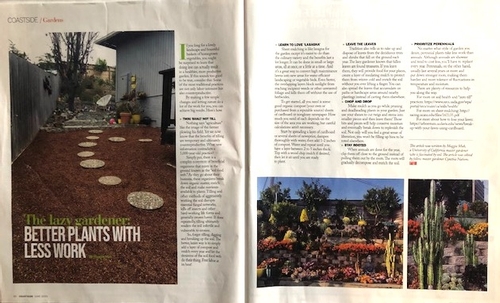If you long for a lovely landscape and bountiful baskets of homegrown vegetables, you might be surprised to learn that doing less can actually result in a healthier, more productive garden. If this sounds too good to be true, consider this: some of the most traditional practices are not only labor-intensive but also counterproductive. By making a few simple changes and letting nature do a lot of the work for you, you can achieve big results. Here's how:
Thou Shalt Not Till
Nothing says “agriculture” like the image of the farmer plowing his field, yet we now know that the benefits of tilling are temporary and ultimately counterproductive. What new information contradicts a 5,000-year-old practice? Simply put, there is a complex ecosystem of beneficial organisms that exist in the ground known as the “Soil Food Web.” As they go about their business, these organisms break down organic matter, enrich the soil and make nutrients available to plants. Tilling and other methods of aggressively working the soil disrupts essential fungal networks, kills off insects and other hard-working life forms and generally creates havoc. If done repeatedly, tilling ultimately renders the soil infertile and vulnerable to erosion. So forget tilling, digging, and breaking up the soil. The better, lazier way is to simply add a layer of compost and mulch every year and let the denizens of the Soil Food Web do their thing. Free labor at its best!
Learn to Love “Lasagna”
Sheet mulching is like lasagna for the garden except it's easier to do than the culinary variety and the benefits last a lot longer. It can be done in small or large areas, all at once or a little at a time and it's a great way to convert high maintenance lawns into new areas for water-efficient landscaping or vegetable beds. Even better: the overlapping layers block sunlight from reaching incipient weeds or other unwanted foliage and kills them off without the use of herbicides.
To get started, all you need is some good organic compost (your own or purchased from a reputable source) sheets of cardboard or non-glossy newspaper. How much you need of each depends on the size of the area you are working but careful calculations aren't necessary. Start by spreading a layer of cardboard or several sheets of newsprint, dampen thoroughly with water then add 1-2 inches of compost. Water and repeat until you have a layer between 2 and 5 inches thick. Top with a wood chip mulch if desired, then let it sit until you are ready to plant.
Leave the Leaves:
Tradition also tells us to rake up and dispose of leaves from the deciduous trees and shrubs that fall on the ground each year. The lazy gardener knows that fallen leaves are found treasures. If you leave them, they will provide food for your plants, create a layer of insulating mulch to protect them from winter cold and enrich the soil without you ever lifting a finger. You can also spread the leaves that accumulate on paths or hardscape areas around nearby plantings instead of carting them elsewhere.
Chop and Drop:
Make mulch as you go while pruning and deadheading plants in your garden. Just use your shears to cut twigs and stems into smaller pieces and then leave them! Those bits and pieces will help conserve moisture and eventually break down to replenish the soil. Not only will you feel a great sense of liberation, you won't be filling up bins to be toted elsewhere.
Stay Rooted:
When annuals are done for the year, clip them off close to the ground instead of pulling them out by the roots. The roots will gradually decompose and enrich the soil.
Prioritize Perennials:
No matter what style of garden you desire, perennial plants take less work than annuals. Although annuals are showier and tend to cost less, you'll have to re-plant every year. Perennials, on the other hand, usually last several years or more and put down stronger roots, making them hardier and more tolerant of fluctuations in temperature and moisture.
Resources:
For more on soil health and “zero till” practices: https://www.nrcs.usda.gov/wps/portal/nrcs/main/ca/soils/health/
For more on sheet mulching: http://sacmg.ucanr.edu/files/163135.pdf
For more about how to lose your lawn: https://arboretum.ucdavis.edu/news/break-up-with-your-lawn-using-cardboard
This article was written by Maggie Mah, a University of California Master Gardener who is fascinated by soil. The article was edited by UC Master Gardeners Cynthia Nations and Maggie Mah.
